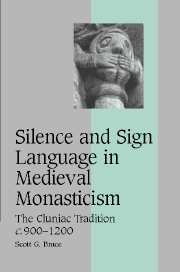Book contents
- Frontmatter
- Contents
- List of tables
- Acknowledgments
- List of abbreviations
- Map
- INTRODUCTION: THE DORMANT LANGUAGE
- 1 UTTERING NO HUMAN SOUND
- 2 THE TRAINING OF THE HAND
- 3 A SILENT COMMERCE OF SIGNS
- 4 TRANSMISSION AND ADAPTATION
- 5 CONTINUITY AND CRITICISM
- CONCLUSION
- Appendix A: The Cluniac sign lexicon
- Bibliography
- Index
- Cambridge Studies in Medieval Life and Thought Fourth Series
5 - CONTINUITY AND CRITICISM
Published online by Cambridge University Press: 16 July 2009
- Frontmatter
- Contents
- List of tables
- Acknowledgments
- List of abbreviations
- Map
- INTRODUCTION: THE DORMANT LANGUAGE
- 1 UTTERING NO HUMAN SOUND
- 2 THE TRAINING OF THE HAND
- 3 A SILENT COMMERCE OF SIGNS
- 4 TRANSMISSION AND ADAPTATION
- 5 CONTINUITY AND CRITICISM
- CONCLUSION
- Appendix A: The Cluniac sign lexicon
- Bibliography
- Index
- Cambridge Studies in Medieval Life and Thought Fourth Series
Summary
Around the year 1100, men and women in all stations and ages of life experienced the awakening of new religious sentiments. Across western Europe, individuals set out to attain ideals of personal perfection on their own terms. Some fled to remote places to live as hermits and solitaries. Others founded or entered houses of new religious orders, where they attempted to recover and embrace the more austere and authentic forms of ascetic life observed in the distant past by the apostles and exemplary monastic saints like Anthony and Benedict. The emergence of new religious orders in this period was not symptomatic of a “crisis” or decline in cenobitic monasticism, but represented instead the attempts of a generation of reformers to encourage the practice of religious values beyond abbey walls. These reformers sought to provide for the spiritual needs of laymen and women, who desired to fulfill their ideals of Christian perfection without having to enter the highly structured life of the cloister. The service of others through itinerant preaching and other forms of active piety was a prominent aspect of this revival, but the personal obligations implicit in the new wave of reform often involved some form of verbal expression and therefore clashed with the cultivation of silence, a virtuous practice that retained its strong currency among the new religious orders.
The collision of righteous speech and pious silence put pressure on reformed monastic communities to find ways to meet their evangelical ideals without compromising time-honored standards of personal discipline.
- Type
- Chapter
- Information
- Silence and Sign Language in Medieval MonasticismThe Cluniac Tradition, c.900–1200, pp. 143 - 170Publisher: Cambridge University PressPrint publication year: 2007

